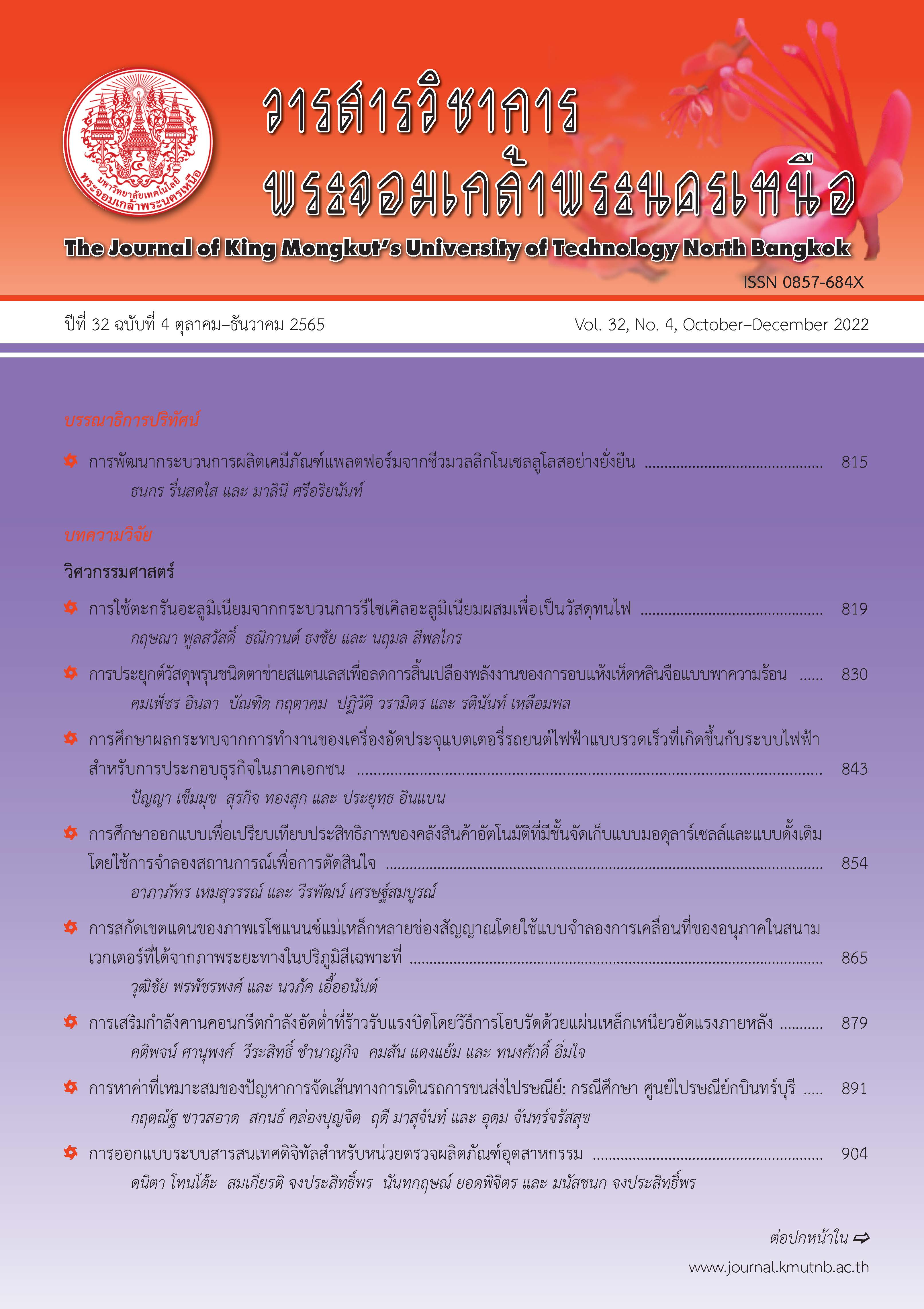การวิเคราะห์องค์ประกอบเชิงยืนยันการศึกษาความเสี่ยงจากการเกิดภัยคุกคามทางอินเทอร์เน็ตของพนักงานระดับปฏิบัติการในภาคธุรกิจอุตสาหกรรมจังหวัดระยอง
Main Article Content
บทคัดย่อ
การวิจัยนี้มีวัตถุประสงค์เพื่อวิเคราะห์องค์ประกอบเชิงยืนยันการศึกษาความเสี่ยงจากการเกิดภัยคุกคามทางอินเทอร์เน็ตของพนักงานระดับปฏิบัติการในภาคธุรกิจอุตสาหกรรมจังหวัดระยอง และตรวจสอบความสอดคล้องโมเดลโครงสร้างองค์ประกอบเชิงยืนยันการศึกษาความเสี่ยงจากการเกิดภัยคุกคามทางอินเทอร์เน็ตของพนักงานระดับปฏิบัติการในภาคธุรกิจอุตสาหกรรมจังหวัดระยองกับข้อมูลเชิงประจักษ์ กลุ่มตัวอย่างจำนวน 263 คน คัดเลือกแบบเจาะจง เครื่องมือที่ใช้ในการวิจัยเป็นแบบสอบถามเรื่องการศึกษาความเสี่ยงจากการเกิดภัยคุกคามทางอินเทอร์เน็ตของพนักงานระดับปฏิบัติการในภาคธุรกิจอุตสาหกรรมจังหวัดระยอง ประกอบด้วย 6 องค์ประกอบ มีค่าความเชื่อมั่นภายในเท่ากับ 0.95 วิเคราะห์ข้อมูลโดยใช้โปรแกรม AMOS ผลการวิเคราะห์องค์ประกอบเชิงยืนยันอันดับแรก พบค่าดัชนีทุกตัวผ่านเกณฑ์ (CMIN = 76.23, CMIN/DF = 1.29, p-value = 0.06, CFI = 0.98, GFI = 0.96, AGFI = 0.93, RMR = 0.03, SRMR = 0.04 และ RMSEA = 0.03) น้ำหนักองค์ประกอบ 0.44-0.87 มีนัยสำคัญทางสถิติที่ .01 และผลการวิเคราะห์องค์ประกอบเชิงยืนยันอันดับสอง พบค่าดัชนีทุกตัวผ่านเกณฑ์ (CMIN = 69.05, CMIN/DF = 1.23, p-value = 0.11, CFI = 0.99, GFI = 0.96, AGFI = 0.93, RMR = 0.03, SRMR = 0.04 และ RMSEA = 0.03) น้ำหนักองค์ประกอบ 0.22-0.96 มีนัยสำคัญทางสถิติที่ .01 โดยองค์ประกอบที่มีค่าน้ำหนักเรียงจากมากไปหาน้อย ได้แก่ ด้านความมั่นคงปลอดภัย ด้านการกลั่นแกล้งทางไซเบอร์ ด้านตระหนักรู้ ด้านแรงจูงใจ ด้านความรู้ และด้านพฤติกรรม ตามลำดับ เพื่อเป็นแนวทางในการพัฒนาหรือส่งเสริมการป้องกันความเสี่ยงจากการเกิดภัยคุกคามทางอินเทอร์เน็ตของพนักงานระดับปฏิบัติการในภาคธุรกิจอุตสาหกรรม
Article Details

อนุญาตภายใต้เงื่อนไข Creative Commons Attribution-NonCommercial-NoDerivatives 4.0 International License.
บทความที่ลงตีพิมพ์เป็นข้อคิดเห็นของผู้เขียนเท่านั้น
ผู้เขียนจะต้องเป็นผู้รับผิดชอบต่อผลทางกฎหมายใดๆ ที่อาจเกิดขึ้นจากบทความนั้น
เอกสารอ้างอิง
B. Boonyakit, Knowledge Management from Theory to Practice. Bangkok: Jirawat Express, 2004 (in Thai).
N. Wongyai, “Enhancing information skills in the labor market to prevent the threats of internet,” TLA Bulletin, vol. 61, no. 2, pp. 64–75, 2017 (in Thai).
National Intelligence Agency. (2019, April). Terrorism prevention guide. National Intelligence Agency, Thailand. [Online]. Available: https://www.nia. go.th/iwebtemp/25631126/91288995910373. pdf
Thailand Computer Emergency Response Team. (2020, September). Internet threat statistics 2016-2019. Thailand Computer Emergency Response Team, Thailand. [Online]. Available:https://www.thaicert.or.th/statistics/ statistics.html
C. V. Good, Dictionary of Education. New York: McGraw-Hill Book, 1973.
B. S. Bloom, J. T. Hastings, and G. F. Madaus, Hand Book on Formative and Summative Evaluation of Student Learning. New York: McGraw-Hill Book, 1971.
D. Payne and S. Goedeke, “Holding together: Caring for clients undergoing assisted reproductive technologies,” Journal of Advanced Nursing, vol. 60, pp. 645–653, 2007.
J. A. Smith, “Hermeneutics, human sciences and health: Linking theory and practice,” International Journal of Qualitative Studies on Health & Well-Being, vol. 2, no. 1, pp. 3– 11, 2007.
K. Onvimol. (2020, September). Information system security. Songkhla Rajabhat University, Thailand. [Online]. Available: https://sites. google.com/site/ges0503chiwitkabthekhnoloyi/ bth-thi-5-khwam-mankhng-plxdphay-khxngrabb- sarsnthes/7-phay-khukkham
Deparment of Industrial Works. (2019, August). Industry statistics. Department of Industrial Works, Thailand. [Online]. Available: https:// www.diw.go.th/hawk/content.php?mode =spss63
J. F. Hair, W. C. Black, B. J. Babin, and R. E. Anderson, Multivariate Data Analysis, 7th ed. Upper saddle River, NJ: Pearson Education International, 2010.
A. L. Comrey and H. B. Lee, A First Course in Factor Analysis, 2nd ed. Psychology Press, 2016.
B. G. Tabachnick and L. S. Fidell, Using Multivariate Statistics. Boston, MA: Pearson Education, 2007.
L. J. Cronbach, Essentials of Psychological Test, 5th ed. Harper Collins, 1970.
R. E. Schumacker and R. G. Lomax, A Beginner’s Guide to Structural Equation Modeling, Routledge, 2010.
H. Liang and Y. Xue, “Avoidance of information technology threats: A theoretical perspective,” MIS Quarterly, vol. 33, no. 1, pp. 71–90, 2009.

